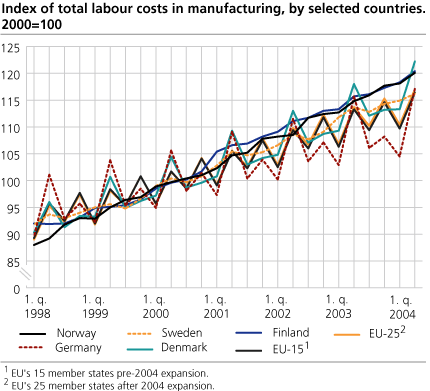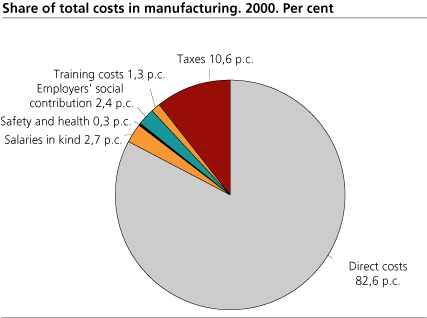Content
Published:
This is an archived release.
Increase in labour costs per hour
Total labour costs per hour increased by 4.6 per cent in the electricity supply industry from the second quarter to third quarter of 2004, according to the labour cost index, a new statistics from Statistics Norway. The purpose of the index is to measure the development in labour costs. The index will present labour costs per paid hour every quarter, and is now published with indices back to the first quarter of 1998.
Total labour costs is defined as the total cost of having an employee, and includes direct costs and indirect costs. Direct costs include wages and salaries, holiday pay and other costs for days not worked. Direct costs make up more than 80 per cent of the total costs. Indirect costs include salaries in kind, costs for safety and health, social contributions, taxes and training costs.
The average of the four quarters of 2000 is the reference value, i.e. 2000=100.
Changes throughout the year
The labour cost index varies throughout the year. The main reason for the changes are increases or decreases in wages and salaries. Seasonal variations can be attributed to the payment of bonuses, which are more likely to be paid in the first or fourth quarter, and payment for overtime work. Tax-payments for employers' national insurance contributions have increased from 2000 to 2004, and will contribute to changes through the year if the average level increases or decreases.
Changes from the second quarter to the third quarter of 2004
The index for employees in the manufacturing industry shows a 1.0 per cent increase in labour costs per paid hour from the second to the third quarter of 2004. For the other industries, the changes were:
- Oil and gas extraction and mining decreased by 1.8 per cent
- Electricity supply increased by 4.6 per cent
- Construction decreased by 0.6 per cent
- Wholesale and retail trade decreased by 1.0 per cent
- Transport and communication decreased by 1.4 per cent
- Real estate and business activities increased by 0.4 per cent
The changes in labour costs per paid hour from the third quarter of 2003 to the third quarter of 2004 were:
- Oil and gas extraction and mining increased by 1.5 per cent
- Manufacturing increased by 4.7 per cent
- Electricity supply increased by 7.6 per cent
- Construction increased by 2.3 per cent
- Wholesale and retail trade increased by 3.8 per cent
- Transport and communication increased by 4.2 per cent
- Real estate and business activities increased by 2.1 per cent
Labour cost indices are also compiled in other European countries. Figures from a selection of countries show that from the first quarter to the second quarter of 2004 labour costs per paid hour in manufacturing increased by 1.7 in Norway, 1.1 per cent in Sweden, 7.9 per cent in Denmark and 1.8 per cent in Finland.
The changes from the second quarter of 2003 to the second quarter of 2004 were 4.6 per cent in Norway, 2.2 per cent in Sweden, 3.6 per cent in Denmark and 4.1 per cent in Finland.
These figures are not adjusted for differences in definitions or payment dates for the various cost-components in different countries.
Sample
The labour cost index is obtained by combining the quarterly wage index, structural statistics on wages, the labour cost survey 1996 and 2000 and wage totals from the Register of End of the Year Certificate. According to the preliminary figures in the national accounts for the third quarter of 2004, about 1 076 000 employees in the industries are covered by this statistics.
For more information about the statistics, go to http://www.ssb.no/english/subjects/06/05/arbkost_en/about.html , wage totals at http://www.ssb.no/english/subjects/06/05/lonntreg_en/about.html , wage index at http://www.ssb.no/english/subjects/06/05/lonnkvart_en/about.html and wage statistics at http://www.ssb.no/english/subjects/06/05/ .
More information about the labour cost index is available at About the index .
Tables:
- Table 1 Labour Cost Index in manufacturing, oil and gas extraction and mining, construction, transport and communication, wholesale and retail trade, real estate and business activities and electricity supply. Average of year 2000=100
- Table 2 Changes in labour cost from the corresponding quarter the year before by industry. Per cent
- Table 3 Direct costs in manufacturing, oil and gas extraction and mining, construction, transport and communication, wholesale and retail trade, real estate and business activities and electricity supply. Average of year 2000=100
- Table 4 Changes in direct costs from the corresponding quarter the year before by industry. Per cent
- Table 5 Indirect costs in manufacturing, oil and gas extraction and mining, construction, transport and communication, wholesale and retail trade, real estate and business activities and electricity supply. Average of year 2000=100
- Table 6 Changes in indirect costs from the corresponding quarter the year before by industry. Per cent
- Table 7 Labour Cost Index in manufacturing, by country. Average of year 2000=100
- Table 8 Average labour costs per paid hour, by section. 2000. NOK
Contact
-
Thomas Hagen
E-mail: thomas.hagen@ssb.no
tel.: (+47) 40 81 13 20
-
Heidi Bekkevold Backe
E-mail: heidi.backe@ssb.no
tel.: (+47) 40 81 13 22
-
Marianne Mellem
E-mail: mnm@ssb.no
tel.: (+47) 40 81 14 42


